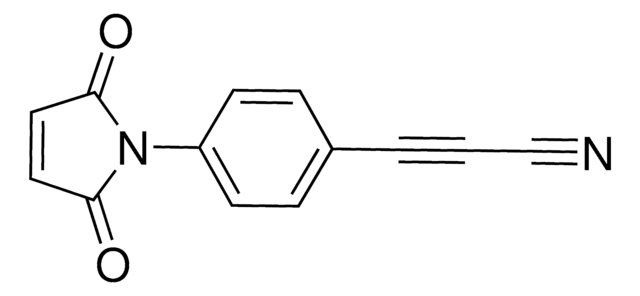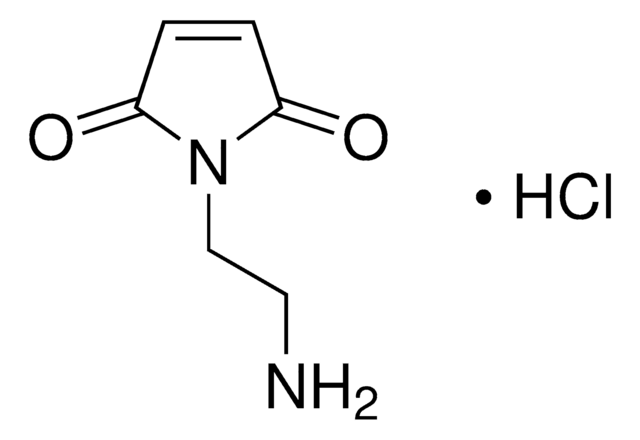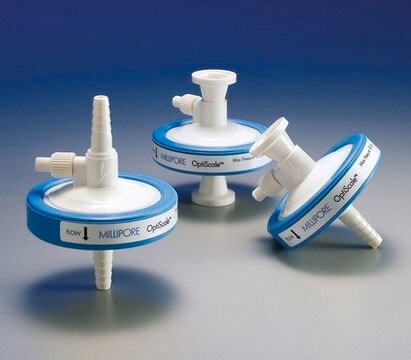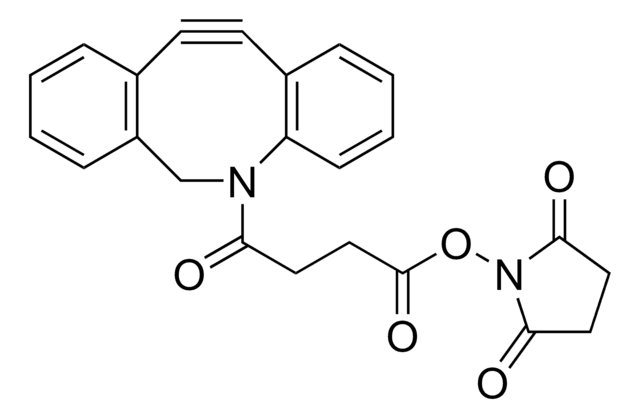おすすめの製品
形状
powder
品質水準
反応適合性
reagent type: cross-linking reagent
官能基
ester
保管温度
−20°C
SMILES記法
O=C(OC1=C(F)C(F)=C(S(=O)(O[Na])=O)C(F)=C1F)C2=CC=C(C#CC#N)C=C2
InChI
1S/C16H5F4NO5S.Na/c17-10-12(19)15(27(23,24)25)13(20)11(18)14(10)26-16(22)9-5-3-8(4-6-9)2-1-7-21;/h3-6H,(H,23,24,25);/q;+1/p-1
InChI Key
YFJYSJRZDOWXDH-UHFFFAOYSA-M
関連するカテゴリー
詳細
CBTF (Sodium 4-((4-(cyanoethynyl)benzoyl)oxy)-2,3,5,6-tetrafluorobenzenesulfonate) is a heterobifunctional reagent. It bears a 3-arylpropionitrile (APN) group. CBTF can be prepared from 4-iodobenzoic acid. It participates in various amine-to-thiol coupling reactions. It participates in the synthesis of various antibody-dye conjugates. CBTF is widely used for antibody conjugation.
アプリケーション
CBTF is a bifunctional crosslinker for amine-to-thiol coupling. The coupling can be performed with high selectivity in biological medium using mild reaction conditions. CBTF readily reacts with organic amines in basic conditions to produce APN-probes suitable for cysteine labeling.
その他情報
Standard protein labeling procedure (lysine labeling):
Standard protein labeling procedure (cysteine labeling):
Dissolve the protein in the appropriate buffer* with pH 6.5-9.0 (e.g. PBS) at 1-10mg/mL concentration.
Apply the appropriate amount of the stock solution of the APN-labeled molecule (1-5 molar eq. per free cysteine residue).
Incubate at room temperature for 2 hours.
If necessary, purify the protein conjugate using size exclusion chromatography or ultrafiltration.
*Note: avoid amine- and thiol-containing buffers.
- Dissolve the protein in an appropriate buffer* with pH 7.5-9.0 (e.g. PBS) at 1-10mg/mL concentration.
- Apply the appropriate amount of the stock solution of the reagent (1-5 molar eq. per lysine residue).
- Incubate at room temperature for 2 hours.
- If necessary, purify the protein-APN conjugate using size exclusion chromatography or ultrafiltration.
- The conjugate can be readily coupled with thiol-containing substrates by incubating the components in aqueous buffer (pH 6.5-9.0) at ambient temperature for 2 hours.
Standard protein labeling procedure (cysteine labeling):
Dissolve the protein in the appropriate buffer* with pH 6.5-9.0 (e.g. PBS) at 1-10mg/mL concentration.
Apply the appropriate amount of the stock solution of the APN-labeled molecule (1-5 molar eq. per free cysteine residue).
Incubate at room temperature for 2 hours.
If necessary, purify the protein conjugate using size exclusion chromatography or ultrafiltration.
*Note: avoid amine- and thiol-containing buffers.
シグナルワード
Danger
危険有害性情報
危険有害性の分類
Acute Tox. 3 Oral
保管分類コード
6.1C - Combustible, acute toxic Cat.3 / toxic compounds or compounds which causing chronic effects
WGK
WGK 3
引火点(°F)
Not applicable
引火点(℃)
Not applicable
試験成績書(COA)
製品のロット番号・バッチ番号を入力して、試験成績書(COA) を検索できます。ロット番号・バッチ番号は、製品ラベルに「Lot」または「Batch」に続いて記載されています。
この製品を見ている人はこちらもチェック
Houzong Yao et al.
International journal of molecular sciences, 17(2), doi:10-doi:10 (2016-02-06)
Antibody-drug conjugates (ADCs) have become a promising targeted therapy strategy that combines the specificity, favorable pharmacokinetics and biodistributions of antibodies with the destructive potential of highly potent drugs. One of the biggest challenges in the development of ADCs is the
Construction of homogeneous antibody-drug conjugates using site-selective protein chemistry.
Akkapeddi P, et al.
Chemical Science, 7(5), 2954-2963 (2016)
Sergii Kolodych et al.
Bioconjugate chemistry, 26(2), 197-200 (2015-01-24)
Amine-to-thiol coupling is the most common route for the preparation of antibody-drug conjugates (ADC). It is usually achieved by using heterobifunctional reagents possessing an activated ester at one end and a maleimide group at the other. However, maleimide-based conjugates were
ライフサイエンス、有機合成、材料科学、クロマトグラフィー、分析など、あらゆる分野の研究に経験のあるメンバーがおります。.
製品に関するお問い合わせはこちら(テクニカルサービス)![LC-SPDP (succinimidyl 6-[3(2-pyridyldithio)propionamido]hexanoate)](/deepweb/assets/sigmaaldrich/product/structures/300/586/d95fd80c-e201-4b0b-8aee-31e109c2ff41/640/d95fd80c-e201-4b0b-8aee-31e109c2ff41.png)









![(1R,8S,9s)-ビシクロ[6.1.0]ノン-4-イン-9-イルメチルN-スクシンイミジルカーボナート for Copper-free Click Chemistry](/deepweb/assets/sigmaaldrich/product/structures/969/022/d6776082-2f7a-47c7-bcd4-3830dac0fb7d/640/d6776082-2f7a-47c7-bcd4-3830dac0fb7d.png)
